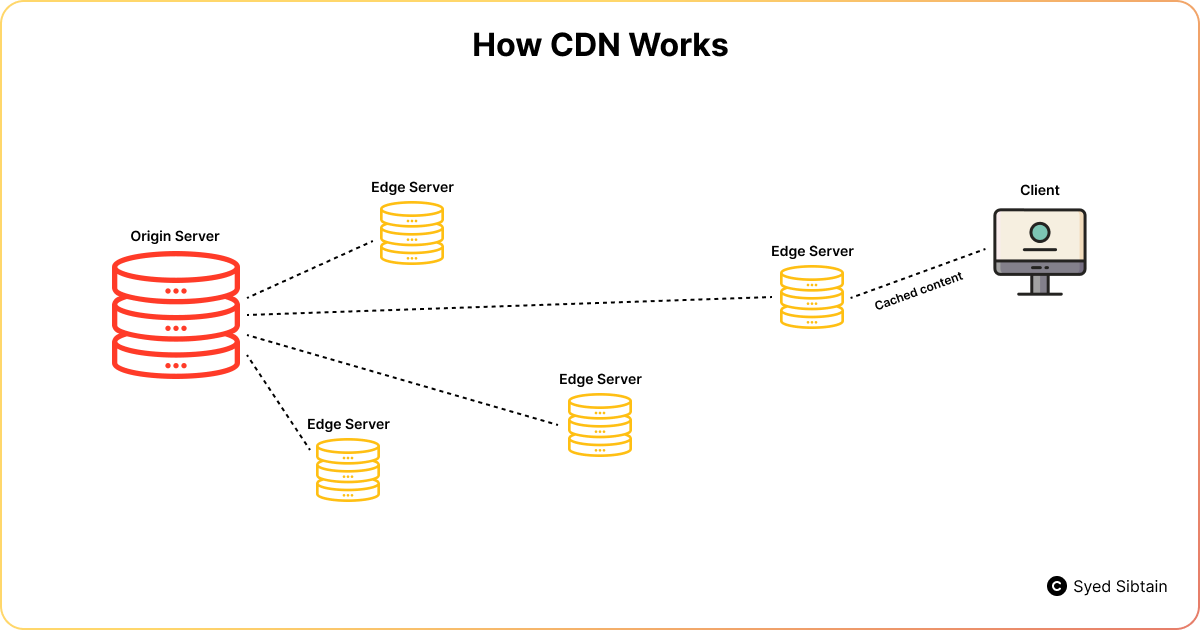What is a CDN? A Comprehensive Guide to Content Delivery Networks
 Syed Sibtain
Syed Sibtain
Introduction
What is CDN (Content Delivery Network)
The term "content delivery network" (CDN) refers to a distributed network of servers that work together to efficiently and rapidly deliver web content. A CDN caches and distributes content across numerous carefully positioned servers around the world rather than depending on a single server to handle all user requests. This improves load speeds and reduces latency by ensuring that users can access data from the nearest server.
How Does a CDN Work?
When a user requests content from a website, like an image, video, or HTML page, the request is sent to the nearest CDN server instead of the website's main server. If a cached version of the content is available, the CDN delivers it, significantly reducing the load time. If the content is not cached, the CDN gets it from the original server and sends it to the user.
To understand how a CDN works, let's look at its main components:
Origin server: The origin server is the primary location where a website's original content is stored. This could be a regular web server, a cloud storage system, or an application server. The CDN gets content from this source and spreads it across its global network.
Edge Servers (CDN Nodes): Edge servers, also known as Points of Presence (PoPs), are strategically placed data centers worldwide. These servers store cached copies of website content and deliver it to users based on their geographic location.
Caching: CDNs use caching to store frequently accessed content on edge servers. Cached content includes static files like images, CSS, JavaScript, and even dynamically generated pages. When a user requests content, the CDN first checks if it is available in the cache before retrieving it from the origin.
Cache Expiration & Invalidation:
Time-to-Live (TTL): Defines how long content remains cached before being updated.
Purge Requests: Allows website owners to manually refresh content if immediate updates are needed.

This is all well and good, but it makes us all ask the question: Why use a CDN?
Why CDN?
CDNs provide several benefits, making them essential for modern websites and applications. And here, I'll share some of the benefits that I believe are most important to consider.
Faster Website Loading Times:
One of the main benefits of using a CDN is faster page load speed. Because CDN servers are spread out worldwide, they reduce the physical distance between users and the content they want. This leads to lower latency and quicker loading times, which directly enhances user experience and engagement.For example, if I'm in India and trying to access a website hosted in the US, the data would have to travel a long distance, causing delays. However, with a CDN, the content is served from a nearby server in India, ensuring a much faster and smoother experience.
Global Reach and Scalability:
Furthermore, a CDN allows websites to scale easily and manage high traffic volumes without overloading the main server. Whether the users are in North America, Europe, or Asia, a CDN ensures they receive content quickly, improving global accessibility.Better Reliability and Uptime:
A CDN ensures that even if one server goes down, traffic is redirected to another available nearby server, preventing website downtime. This redundancy boosts reliability, making websites more resilient to sudden traffic spikes or server failures.Improved SEO Rankings:
Since Google considers page speed a ranking factor, using a CDN can significantly affect Search Engine Optimization (SEO). Faster loading times lead to reduced bounce rates and better user engagement, all of which contribute to higher search rankings.Reduced Bandwidth Costs:
When a website is accessed, the content (like images, videos, and scripts) is usually fetched from the origin server, which can lead to high bandwidth usage. Bandwidth is the amount of data transferred between the server and the user, and hosting providers often charge based on this usage.A CDN helps lower these costs by caching copies of the website’s content on multiple edge servers around the world. When a user requests content, the CDN delivers it from the nearest edge server instead of repeatedly fetching it from the origin server. This reduces the data transferred from the main server, leading to lower bandwidth usage and, consequently, reduced hosting costs.
CDNs for Packages:
And yes! This is my favourite 🚀. CDNs are commonly used to deliver frontend libraries and packages like React, Bootstrap, jQuery, and others. Instead of hosting these libraries on our own server, we can load them from a CDN, which offers several benefits:Example:
Instead of installing Bootstrap via npm, we can include it directly from a CDN like this:<!-- Bootstrap from a CDN --> <link href="https://cdn.jsdelivr.net/npm/bootstrap@5.3.0/dist/css/bootstrap.min.css" rel="stylesheet"> <script src="https://cdn.jsdelivr.net/npm/bootstrap@5.3.0/dist/js/bootstrap.bundle.min.js"></script>
We can use a CDN for a quick setup, improved caching, and reduced server load, which is great for simple static sites.
Conclusion
CDNs are essential for enhancing website performance, security, and reliability by delivering content from servers closer to users. They help reduce load times, lower bandwidth costs, and protect against cyber threats like DDoS attacks.
While CDNs provide many advantages, they also have some downsides. Premium CDNs can be costly, especially for high-traffic websites, as expenses increase with usage. If not configured correctly, caching issues might occur, potentially serving outdated content to users until the cache is updated. Despite these drawbacks, the benefits of using a CDN often make it a crucial tool for modern web development.
Subscribe to my newsletter
Read articles from Syed Sibtain directly inside your inbox. Subscribe to the newsletter, and don't miss out.
Written by
